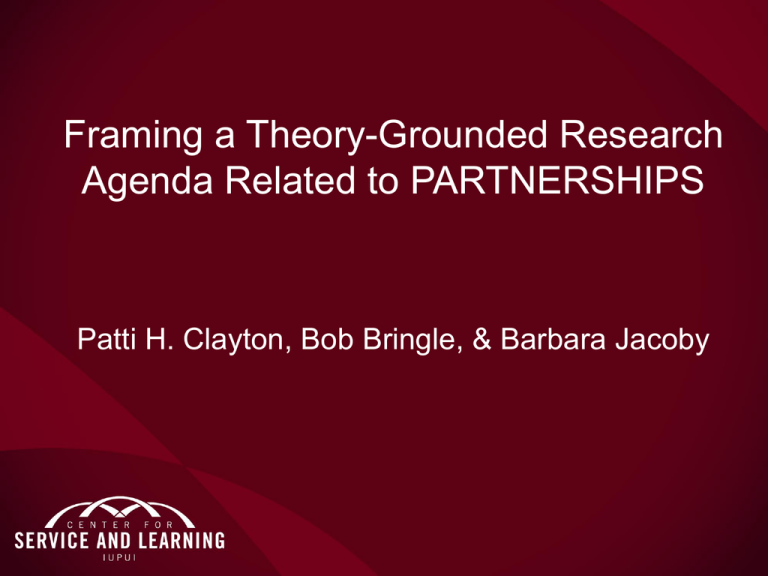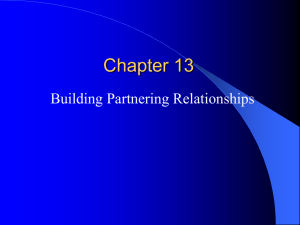Partnerships - 2012 Proceedings Homepage
advertisement

Framing a Theory-Grounded Research Agenda Related to PARTNERSHIPS Patti H. Clayton, Bob Bringle, & Barbara Jacoby IUPUI Series on Service Learning Research Research on Service Learning: Conceptual Frameworks and Assessment Vol 2A: Students & Faculty Vol 2B: Communities, Institutions, & Partnerships (Stylus 2013) Theory Measurement Design Practice Focusing on theory “Bringle (2003) has advocated for theory from cognate areas to be clearly used as a basis of research. These could include theories from psychology about motivation, interpersonal relationships, and cognitive and moral development; from business about interorganizational relationships, leadership, and change management; from philosophy about value systems and decision-making; from political theory about individual and collective action; from history about social movements; from communication about conflict resolution.” Focusing on theory “The theory or conceptual framework might precede the data collection, or it might emerge from or be modified based on data analysis and interpretation. Procedures for measuring quantitative or qualitative aspects of attributes do not stand alone, and their meaningfulness is often a function of how solidly they are situated in theory.” Research on Service Learning: Conceptual Frameworks and Assessment • • • • • I. STUDENTS II. FACULTY III. COMMUNITIES IV. INSTITUTIONS V. PARTNERSHIPS Section: PARTNERSHIPS • Conceptual frameworks • Organizational partnerships • Student partnerships Chapter template • • • • • • Theoretical / conceptual frameworks Critical review of past research Measurement approaches and instruments Implications for practice Future research agenda Recommended reading Lets do some of this same thinking together …. Critical review of research to date: PARTNERSHIPS (+) Participants? Authors? (Δ) Conceptual Frameworks for Partnerships in Service Learning Robert G. Bringle, Ph.D., Phil.D. Appalachian State University Indiana University-Purdue University Indianapolis Patti Clayton, Ph.D. PHC Ventures Indiana University-Purdue University Indianapolis University of North Carolina at Greensboro New England Resource Center for Higher Education, UMass-Boston Gaps/Issues in Research/Theory • • • • • • • • Neglect of partnerships Campus-Community: Unit of Analysis “Relationships” vs. “Partnerships” Outcomes must be “equal” LOTS of descriptive research Can they be measured? Can they be analyze? Can they be improved (is that desirable, always?)? Relationship > Partnership IUPUI SERIES ON SERVICE LEARNING RESEARCH Theoretical Perspectives • Exchange Theory (Bringle & Hatcher) • Transactional/Transformational (Enos & Morton) • Identity and Relationships (Social Psychology) • Negotiated Order Theory (Dorado & Giles) Theoretical Lens: Exchange Theory • • • • • • • • • • Relationships: Between persons Outcomes = fn( Rewards – Costs) Categories of Outcomes: Trust & Respect Attraction = fn( Outcomes – Comparison Level) Dependency = fn( Outcomes – Comparison Level for Alternatives) Closeness = fn(Frequency of interaction, Diversity of interaction, Interdependency) Equity: Similarity in ratio of outcomes/inputs Transition from “My Outcomes” to “Our Outcomes” Mini-Max Principle Relationship Phases: (a) “shopping” (b) initiation, (c) development, (d) maintenance, (e) dissolution Recommendations for Future Research: Relationships • Expand perspective of relationships beyond “campus-community partnership” • SOFAR model – Student – Organizational staff – Faculty – Administrators on campus – Residents or clients SOFAR Students 5 1 10 Faculty 4 Administrators 2 9 6 8 7 Community Organization Community 3 Residents SOFAR Recommendations for Future Research: Measurement TRES-I: 9-item self-report – Content • outcomes, • common goals, • decision making, • resources, • conflict • management, • identity formation, • power, significance, • satisfaction and • change for the better -Clayton, Bringle, Senor, Huq, & Morrison, 2010, MJCSL Recommendations for Future Research: Measurement TRES-I (Faculty respondents only) • r = .63 with Venn measure of closeness • r = .56 with composite measure of closeness • Desired > Current -Clayton, Bringle, Senor, Huq, & Morrison, 2010, MJCSL Research: Additional Directions • Need to collect data from the rest of SOFAR’s relationships • Need longitudinal studies • Need to consider perspective Partnership Analysis Person 1 Person 2 Actual Similarity Perceived Similarity P1 perception of P2 Understanding Perceived Similarity P2 perception of P1 Research: Additional Directions • Can use SOFAR to analyze partnership qualities and deliberative dialog about improvement, if appropriate – Dewey emphasizes the importance of face-to-face interactions in building relationships and a sense of community, but how critical are they in a world of increasing technology-assisted communication? • Can compare quality of relationship(s) to other data sources – archival – records of communications – decisions about the distribution of resources Research: Additional Directions • Compare networks (more extensive vs. less extensive) • Study relationships over time • Compare to evidence of success and regression – performance indicators – program outcomes – student learning – constituency satisfaction – quality of life indicators Research: Additional Directions • • • • • • Waller’s Principle of Least Interest Focus on “casualties” Regression and growth TransactionTransformation Differences in expectations Measurement as an intervention – Network mapping by constituencies Student Partnerships in Service Learning: More Questions than Answers Barbara Jacoby, Ph.D. bjacoby@umd.edu Theoretical and Conceptual Frameworks • The Foundational Work of Dewey and Freire • Student Development Theories and Frameworks *Musil’s 6 Phases of Citizenship *Social Change Model of Leadership Development *Peer Education/Leadership *Youth Empowerment Theoretical and Conceptual Frameworks • Community-Campus Partnerships as Models for Student Partnerships *SOFAR, TRES *Campus Compact’s Benchmarks for Campus/Community Partnerships *CCPH’s Principles of Good CommunityCampus Partnerships. Social Change Model of Leadership Development Individual • Consciousness of self • Congruence • Commitment Social Change Model of Leadership Development Group • Collaboration • Common purpose • Controversy with civility Community • Citizenship Social Change Model of Leadership Development Ultimate goal: CHANGE SCM Potential Research Questions • What is it about student partnerships in SL that leads to these desired outcomes? Is it the type of activity, the duration, the intensity, the reflection? • Do students who serve as partners in SL achieve any of these outcomes to a greater extent than students who are only participants? • Do student participants advance in the 7 Cs to a greater extent if student partners serve as peer leaders? • Questions? • Ideas? • Implications?





